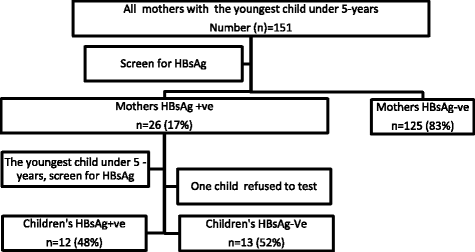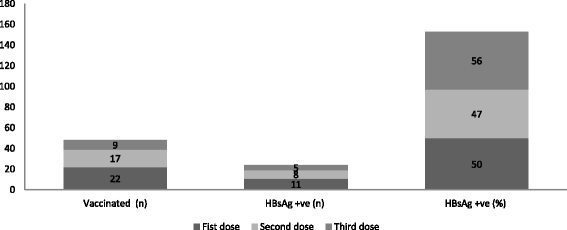Prevalence and risk factors of hepatitis B infection among mothers and children with hepatitis B infected mother in upper Dolpa, Nepal
- PMID: 29017456
- PMCID: PMC5633872
- DOI: 10.1186/s12879-017-2763-4
Prevalence and risk factors of hepatitis B infection among mothers and children with hepatitis B infected mother in upper Dolpa, Nepal
Abstract
Background: Hepatitis B Virus (HBV) infection is a worldwide public health problem. In Nepal, the prevalence of HBV is found to be low (0.9%), although high prevalence (≥8%) of HBV infection is depicted among subgroup/population in the mountain region by various studies. This study assessed the prevalence and the risk of HBV infection among mothers, as well as among the youngest child under 5 years old living with hepatitis B positive mothers in Dolpa, the most remote mountain district of Nepal.
Methods: The cross sectional study survey was conducted between June and July 2014. All mothers with their youngest child under 5 years old were invited to participate in the survey and tested for hepatitis B surface antigen (HBsAg). The HBsAg positive mothers were further tested by 5-panel HBV test card. Children living with HBsAg positive mothers were also tested for HBsAg.
Results: One hundred fifty-one mothers, comprising 37% of the total study population in the selected Village Development Committees (VDCs), were surveyed in the mobile health camps. The seroprevalence of HBsAg among mothers and their youngest child under 5 years old living with HBsAg positive mothers were 17% (95% CI, 11.01-22.99%) and 48% (95%CI, 28.42-67.58%) respectively. The majority of HBV infected mothers were indigenous (84%) followed by Dalit (4%) and other castes (12%). Among HBV infected mothers, 40% were hepatitis B envelope antigen (HBeAg) positive. The prevalence of HBsAg was higher among children living with HBeAg positive mothers as compared to HBeAg negative (60% vs 40%) and male children compared to female (60% vs 33%). Thirty-six percent of children were vaccinated with a full course of the hepatitis B vaccine. Of these vaccinated children, 56% were HBsAg sero-positive.
Conclusions: The HBV infection rate is high among mothers and children living with HBsAg positive mothers in the indigenous population of the most remote mountain community of Nepal.
Keywords: Children; Hepatitis B infection; Mothers; Nepal; Upper Dolpa.
Conflict of interest statement
Authors’ information
PRS was completing a PhD in public health while conducting the study at the DCMPH, at present he is working with the Ministry of Health in Nepal. MDD is a professor and head of the DCMPH. MRB is a professor at Central Department of Microbiology, Tribhuvan University, Nepal. HL was completing a PhD in public health at the DCMPH. SD is lab technologist at National Public Health Laboratory, Department of Health Services in Nepal.
Ethics approval and consent to participate
Ethical approval was given by the Institutional Review Board, Institute of Medicine/Tribhuvan University (IOM/TU) [(REF: 295 (6–11-E) 2 070/071; 10–07-2014] to conduct the study. Informed consent was obtained from the participants prior to the start of the study.
Consent for publication
Not applicable.
Competing interests
The authors declare that they have no competing interests.
Publisher’s Note
Springer Nature remains neutral with regard to jurisdictional claims in published maps and institutional affiliations.
Figures
References
-
- WHO. Weekly epidemiological record, Hepatitis B vaccines, WHO position paper. 2009. http://www.who.int/wer/2009/wer8440.pdf.
-
- WHO. Guidelines for the prevention, care and treatment of persons with chronic hepatitis B infection. 2015. http://apps.who.int/iris/bitstream/10665/155081/1/WHO_HIV_2015.5_eng.pdf.... - PubMed
-
- Anna SF, Lok MD. Chronic Hepatitis B. N Engl J Med. 2002;346:1682–83. doi: 10.1056/NEJM200205303462202. - PubMed
MeSH terms
Substances
LinkOut - more resources
Full Text Sources
Other Literature Sources
Medical



